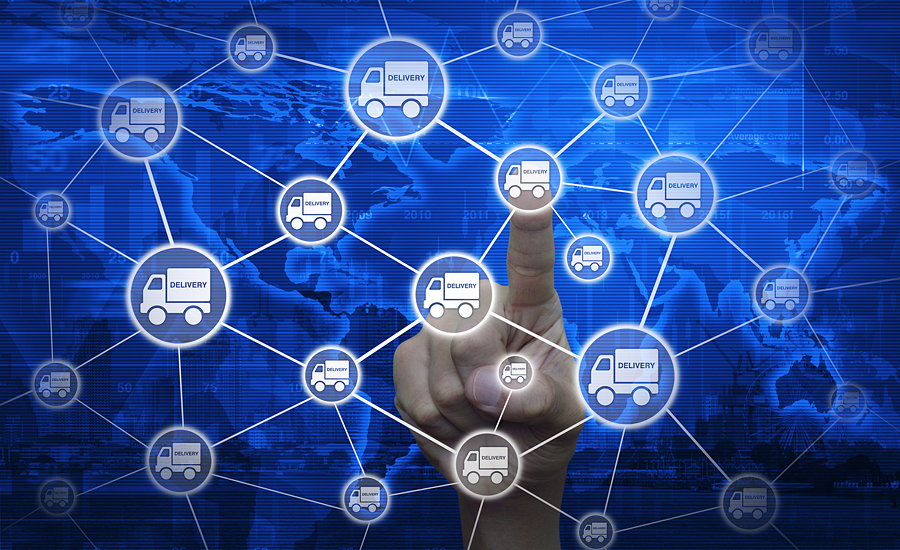The next-generation supply chain market is scheduled to reach $75 billion by 2030, up from $32 billion in 2019, according to “Next-Gen Supply Chain Market – Global Forecast to 2030,” a study released by LogisticsIQ, Singapore.
Enablers of digital supply chain include artificial intelligence (AI), 3D printing, cloud computing, Big Data, predictive analytics, robotics, automation, data capture, driverless vehicles and drones, digital twins, Internet of Things (IoT), blockchain, augmented and virtual reality, wearable and mobile devices and 5G connectivity.
Major drivers of a digital supply chain include demand for greater visibility and transparency in supply chain data process, faster adoption of IoT, increasing investment in supply chain innovation and rising demand from e-commerce.
Companies have started to embrace the digital revolution, and are beginning to see the full potential of Supply Chain 4.0, which includes real-time product visibility, strategic sourcing and optimization, end-to-end visibility, inventory visibility and optimization, real-time manufacturing asset intelligence, micro fulfilment, efficient last mile delivery and dynamic demand and supply synchronization. The proliferation of technologies and opportunities around the digital supply chain means companies need to look seriously at outsourcing these functions. This is going to be a major shift toward new business models as supply chain-as-a-service (SCaaS).
Rise of the digital supply chain market with IoT
Organizations are looking to leverage IoT in supply chain management by installing sensors and communication devices to achieve accurate asset tracking, improve inventory management and predictive maintenance and establish demand-driven supply chain network. Logistics companies having been using smart sensors to increase automated data collection and processing and GPS to improve visibility of shipments and fill-rate for quite some time now.
5G to revolutionize next-gen supply chain market
Widespread 5G rollout is expected to occur starting 2020, promising mobile networks with high data speeds, improved quality and reduced latency. With growing number of smart devices being used in supply chain, there is a challenge to handle all on one network, which can be addressed by 5G to track the even smallest item, V2X communication and order fulfillment through augmented reality in warehouses. 5G is likely to enable massive amounts of data to be collected from remote and mobile sensors analyzed in real time to drive transportation management optimization and predictive analytics. Assuming there will be at least 5 million mobile robots in more than 50,000 warehouses to pick, store, sort and transport the materials and everything will be connected through warehouse management systems and transportation management systems. It makes really important to have a fast, stable and secure connection of 4G LTE or 5G.
AI and supply Chain 4.0
AI in supply chain is being used to address key challenges such as constant change in process, shorter product lifecycle and increased demand uncertainty by analyzing complex data and forecast future demand. AI is already being deployed in supply chain planning and optimization, including demand forecasting, inventory management, warehouse management and fleet management. If supply chain has to be dynamic, responsive and interconnected to the ecosystem, companies should implement solutions that provide end-to-end visibility, real-time insights and recommended actions to turn disruptions into opportunities for customer engagement, growth and profit.
The age of robotics in logistics
The rise in e-commerce has led robots to enter warehouses and sorting centers, and are evening being deployed for micro-fulfillment and last-mile delivery. Autonomous mobile robots (AMRs) are now being used in entire logistics chain, from order intake to customer delivery resulting in faster order fulfillment, greater order accuracy, reduced damages and improved labor productivity. Robots are also being used by large retailers to pack and sort items for warehouse automation. Automated guided vehicles (AGV) are also being deployed in warehouses as autonomous forklifts, carts and pallet movers.
Deploying last-mile delivery with robots and drones
Last-mile service has been identified as key differentiator amongst competitors, from renowned retailers to local businesses. Drones and unmanned ground vehicles (UGV) are showing up in last-mile delivery. Look for robots and drones to fulfill last-mile orders.
Drones the future of logistics
Companies are testing drones for last-mile delivery, and are expected to have a major impact on supply chain. In the future, drones could be the best way to track inventory anonymously and move items quickly.
The micro-fulfillment market shift
Micro-fulfillment brings a distribution center closer to the end-customer, which allows businesses to operate via an online delivery model and reduce costs of last-mile delivery for retailers. Micro-fulfillment centers are small warehouses that utilize high-end automated systems, AI and analytics to deliver goods rapidly.
Blockchain for digital supply chain market
Blockchain in the supply chain establishes provenance of products, authenticity and enhances traceability of the products by transferring information with multiple partners during manufacturing, assembly and transportation in a trusted and automated way.
Impact of 3D printing
With 3D printing technology becoming more accessible, companies are starting to use 3D for on-demand manufacturing and streamline their supply chain. 3D printing allows local facilities to 3D print designs on-demand, leading to significant transportation and logistics cost reduction.
Digital twins optimize supply chain market
Digital twin is another breakthrough technology that creates virtual models of product design, production and IoT, and allows companies to realize new design to have a proper supply china network. Digital twins provide greater insight into and visibility from a material surface to a critical infrastructure, resulting in proactive decisions being deployed in the field. Current use cases in logistics includes digital twins of packaging and containers, shipments, warehouses and distribution centers, logistics infrastructure and logistics networks.
Influx of start-ups
The future supply chain needs to be both intelligent and customer-centric, combined with continuous improvement and an emphasis on innovation in order to consistently deliver value to customers. This has led to the growing need for technology-driven solutions that transform the logistics and supply chain market. Start-ups are taking advantage of technologies that were earlier only limited to large companies.


